|
Body
style: the top lure is a later "thin" Heddon body which has blush (sprayed
on gill marks as opposed the lower earlier lure which has a "fat" body and
hand painted gill marks. Both lures have marked props with the word
"Dowagiac" stamped on the prop which is indicative of the post
1912 time frame. Another detail to note is the length of the wood
body of lures. If you are measuring a lure, measure from wood tip to
wood tip. Not hardware to hardware tip.
|
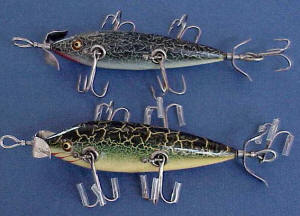 |
|
Gill
marks on marked prop, Heddon L-rig 150's: From the left, sprayed on blush
(later); red nose or head; no gill marks on a frog scale; hand painted
gill marks on a fat body. The fat body would be the older lure
because of the size and hand painted gill marks. |
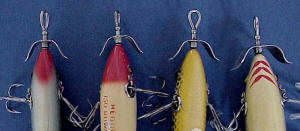 |
|
Belly
weight: This Heddon lure has a single large belly weight and no stencil on
the belly. Only the later lures are stenciled on the belly with
Heddon and the lure name. |
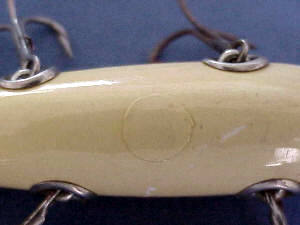 |
|
Belly
weights: An early Heddon 150 with small belly weight and two regular
belly weights, with sweeping gill
marks that extend all the way back to the cup. |
 |
|
A later
Heddon 150 with the stencil on the belly. Many of these lures were
made of Gum wood instead of the earlier Cedar. Paint loss is more
common with the gum wood bodies. |
 |
|
A 1904
Heddon three belly weight Heddon 150. Note the thin tapered nose,
sweeping gill marks, and the 'egg yolk' eye. |
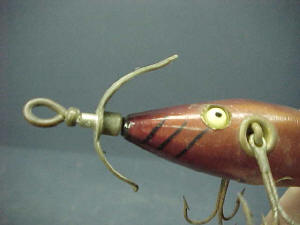 |
|
Heddon gill
Marks and head shape: These three lures are from left to right, Heddon 100
c. 1908 blunt nose, Heddon 150, c. 1908 blunt nose, and a high forehead
150, c. 1905. Note the sweeping gill marks into the cup on the early
150 to the right. The middle 150 has shorter gill marks and a
noticeably more rounded nose. The smaller 100 on the left has only
two gill marks as opposed to the three gill marks on the 150's. The
high forehead has brass hardware and the others have nickel plated
hardware. |
 |
|
A
close-up view of the sweeping gill marks into the Heddon cup area in the
lower photo to illustrate the difference in the two types. The top
lure is a 1908 version of the 150 with a "blunt nose". The middle
photo is of the earlier 1905 150 with a much more pointed nose as well as
the more dramatic gill marks. The bottom photo is of a 1905 high
forehead 300, again with sweeping gill marks. Note too, the gold
wash cups on the 1905 lures. |
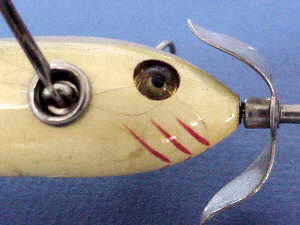   |
|
Transitional
1904-5 Heddon high forehead 300 with red blush on chin. There are no
hand painted gill marks on this version during 1904, instead there
is the sprayed red blush on the chin. |
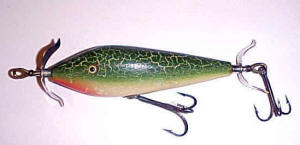 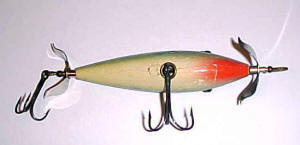 |
|
About
1912, Heddon started stamping their logo "Dowagiac" on the props.
The upper photo shows the earlier unmarked prop and the lower photo the
marked prop. |
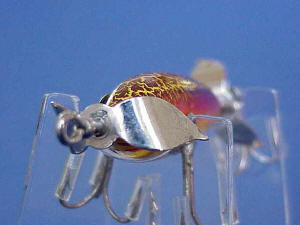  |
|
The
styles of the nose section. Note at the top of the photo, the 1905
vintage high forehead minnow with the sharp pointed head, next down is the
1908 version of the "blunt nose" 150 which would be found in the later
wood boxes, the 1912 type which would be found in the Pinetree box
or in the white box with the double blue lines on the border, progressing
into the early 1920's fat body style and finally, the last two are about
the same type with the more usual slim body. |
 |
|
From top
to bottom: 1905,1908, 1912 150's. |
 |
|
From top
to bottom: 1920's fat body, later 1920's and early 1930's L-rig type
bodies. |
 |















